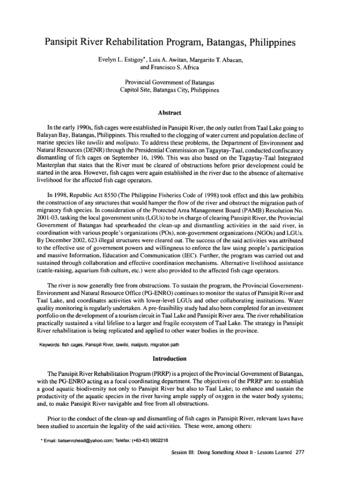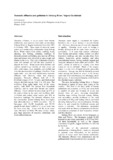Pansipit river rehabilitation program, Batangas, Philippines
- Global styles
- MLA
- Vancouver
- Elsevier - Harvard
- APA
- Help
Share
นามธรรม
In the early 1990s, fish cages were established in Pansipit River, the only outlet from Taal Lake going to Balayan Bay, Batangas, Philippines. This resulted to the clogging of water current and population decline of marine species like tawilis and maliputo. To address these problems, the Department of Environment and Natural Resources (DENR) through the Presidential Commission on Tagaytay-Taal, conducted confiscatory dismantling of fish cages on September 16, 1996. This was also based on the Tagaytay-Taal Integrated Masterplan that states that the River must be cleared of obstructions before prior development could be started in the area. However, fish cages were again established in the river due to the absence of alternative livelihood for the affected fish cage operators.
In 1998, Republic Act 8550 (The Philippine Fisheries Code of 1998) took effect and this law prohibits the construction of any structures that would hamper the flow of the river and obstruct the migration path of migratory fish species. In consideration of the Protected Area Management Board (PAMB) Resolution No. 2001-03, tasking the local government units (LGUs) to be in charge of clearing Pansipit River, the Provincial Government of Batangas had spearheaded the clean-up and dismantling activities in the said river, in coordination with various people s organizations (POs), non-government organizations (NGOs) and LGUs. By December 2002, 623 illegal structures were cleared out. The success of the said activities was attributed to the effective use of government powers and willingness to enforce the law using people s participation and massive Information, Education and Communication (IEC). Further, the program was carried out and sustained through collaboration and effective coordination mechanisms. Alternative livelihood assistance (cattle-raising, aquarium fish culture, etc.) were also provided to the affected fish cage operators.
The river is now generally free from obstructions. To sustain the program, the Provincial Government-Environment and Natural Resource Office (PG-ENRO) continues to monitor the status of Pansipit River and Taal Lake, and coordinates activities with lower-level LGUs and other collaborating institutions. Water quality monitoring is regularly undertaken. A pre-feasibility study had also been completed for an investment portfolio on the development of a tourism circuit in Taal Lake and Pansipit River area. The river rehabilitation practically sustained a vital lifeline to a larger and fragile ecosystem of Taal Lake. The strategy in Pansipit River rehabilitation is being replicated and applied to other water bodies in the province.
การอ้างอิง
Estigoy, E. L., Awitan, L. A., Abacan, M. T., & Africa, F. S. (2005). Pansipit river rehabilitation program, Batangas, Philippines. In M. L. Cuvin-Aralar, R. S. Punongbayan, A. Santos-Borja, L. V. Castillo, E. V. Manalili, & M. M. Mendoza (Eds.), Proceedings of the First National Congress on Philippine Lakes (pp. 277-282). Southeast Asian Regional Center for Graduate Study and Research in Agriculture (SEARCA).
Type
Conference paperISSN
1656-8099คอลเลกชัน
- LakeCon2003 [49]
Related items
Showing items related by title, author, creator and subject.
-
Sugar mill effluents and water quality in Imbang River and Malisbog River, Negros Occidental
Gonzales, Hernane J. (Bureau of Agricultural Research, Department of Agriculture, 2007)The effluents of two sugar mills and the effects on water quality in the receiving rivers were studied. Sugar mill A was located in Barangay Dos Hermanas in Talisay and discharged directly into Imbang River. Sugar Mill B ... -
Domestic effluents and pollution in Imbang River, Negros Occidental
Gonzales, Guadiosa A. (Bureau of Agricultural Research, Department of Agriculture, 2007)Domestic effluents, or waste waters from human settlements, were sampled from eight stations along Imbang River in Negros Occidental from July 1993 to February 1995. Three types of domestic waste waters were produced by ... -
Shrimp pond effluents and water quality in Imbang River, Negros Occidental
Taberna, Evelyn T. (Bureau of Agricultural Research, Department of Agriculture, 2007)The contribution of shrimp farm effluents to the pollution load in Imbang River, Negros Occidental was measured during the period May 1993 to February 1995. Shrimp pond effluents were characterized and the pollution load ...




